When is the sickening trade in Lions going to be banned?
Introduction
Most of the information for this article comes from four articles in the Daily Maverick who have campaigned continuously against captive lion breeding and another in The Conversation. Three are by Don Pinnock entitled Parliament backs NSPCA demand to end captive lion breeding in SA on 4 June 2025 and Lion bones back in the crossfire after breeders challenge sales ban on 18 March 2025 and Hand over your lion bone stockpiles for destruction, minister tells breeders on 17 November 2024. The fourth in Daily Maverick is by Adam Cruise entitled Business as usual for captive lion breeding after SA government keeps the door open on 20 Nov 2024. Lastly an insightful article by Dr Ross Harvey in The Conversation entitled Captive lion breeding in South Africa: the case for a total ban.
All of these articles shine the spotlight on this horrible trade. Some adult lions, especially males, are sold into the canned hunting trade,[1] the remainder have their whole skeletons into the Asian bone trade, the subject of this article. They are often sold as tiger bones in China, where tigers have a certain cachet, but this encourages the further consumption of tigers, that are on the red list of endangered species.[2]
Although breeding lions in captivity is essentially a South African problem, rather than a Zimbabwean one, the issue crosses borders and is particularly relevant to Zimbabwe with an important wildlife tourist industry and small, but thriving, hunting safari operations that offer trophy animals to tourist hunters.[3]
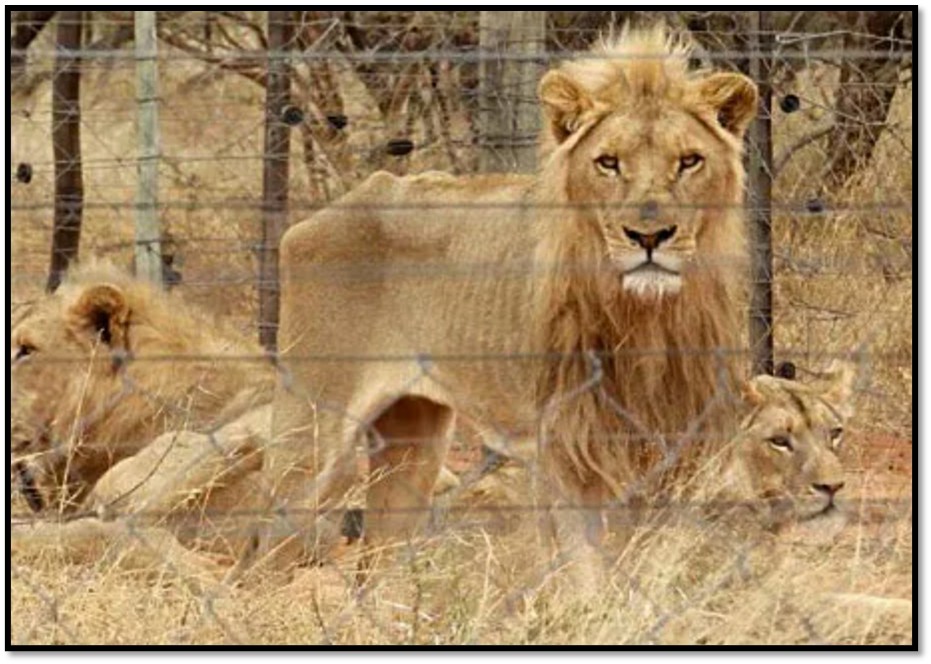
NSPCA: Captive malnourished lions found in shocking condition.
Why is there a trade in captive lions?
The short answer is money. South African breeders responded to a 2019 judgement of the Gauteng Division of the High Court in which the judge ruled an application by breeders to renew the lion bone export quota was “unlawful and constitutionally invalid” and said it failed to consider the wellbeing[4] of captive lions raised and killed for their bones.[5]
In their response to contest the ban the breeders of SA Predator Association (Sapa) revealed that a whole male lion skeleton can fetch R65,000 (US$3,656) and that the eleven members who had filed the notice had 1,530 whole skeletons between them and that their loss at being unable to export them (at an average of US$60,000 would cost them R91.8 million (US$5.16 million)
The scale of the Lion breeding industry in South Africa
Without naming a source, the article[6] states there are between 300-350 lion breeding businesses in South Africa with a combined total of between 8,000-12,000 lions.[7] Using the median value of 10,000 lions with two-thirds being adults (6,667) and all end up as whole skeletons at an average of R60,000 the lion captive industry is worth a current potential of R400 million (US$22.5 million)
In addition, the breeders earn fees from hunting permits when hunter tourists pay for despatching the lions within fenced enclosures. Statistics provided by The Professional Hunters’ Association of SA (PHASA) to the Department of Forestry, Fisheries and the Environment (DFFE) record 2,968 lions killed by hunter tourists between 2016-2023 (521 in 2023) The cost of a lion hunt typically offered by safari operators ranges from US$7,900-US$25,000 for a full-maned male[8] and about $5,900 for a female.[9]
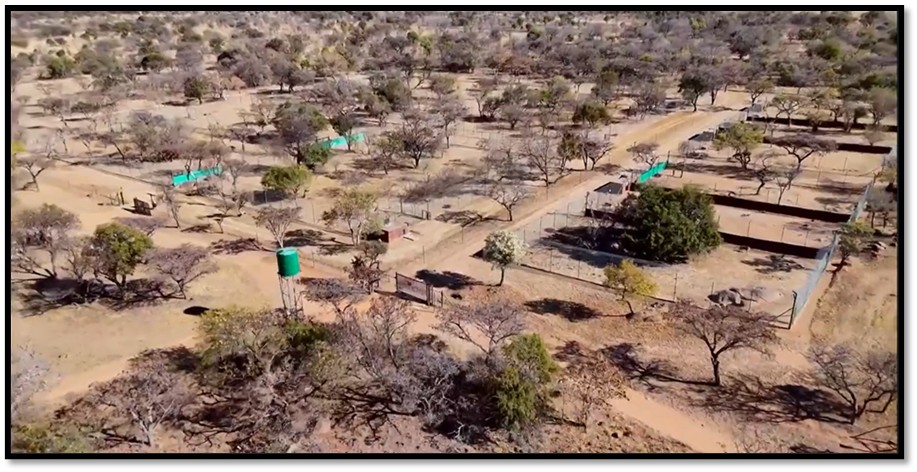
ITVX: a typical lion breeders farm in Limpopo Province, South Africa
Is the South African Government doing enough?
Given that the country has the largest number of lions in captivity…clearly not. In an interview with the secretary of the DFEE she admitted they don’t know how many businesses are breeding lions and only have an estimate of the numbers of lions in captivity.
Despite the known welfare disquiets, the South African government has been slow on this particular environmental predicament despite knowing about welfare concerns such as removing cubs from their mothers soon after birth.[10]
As long ago as 2022, the then Minister of Environment, Forestry and Fisheries, Barbara Creecy, outlined a clear roadmap to phase out the captive lion industry. This included a moratorium on breeding, an end to lion bone stockpiling and a halt to issuing new permits.
But Douglas Wolhuter, on behalf of the NSPCA[11] told MP’s that none of these measures have been adequately implemented, facilities continued to breed cubs unchecked, stockpiles of lion bones persisted, and the NSPCA was left to confront mounting cruelty cases with limited resources and little support from the justice system.
Dr Harvey believes the South African government should not continue to allow the industry to operate; it contradicts the 2018 Parliamentary resolutions calling for laws to shut the captive lion industry down.
Some commentators argue that captive lions compensate for lions lost to poachers
Lion breeders have been known to advance this false argument. However, the fact is that lion numbers have been halved in the last twenty years. They number approximately 24,000 down from an estimated 200,000 once; less than the estimated 27,000 rhinos in the wild.
Is captive Lion breeding lawful?
Captive breeding is permissible under the Convention on International Trade in Endangered Wild Fauna and Flora (CITES) but many wildlife charities and organisations have been calling for the trade in captive lions to be banned.[12]
Clearly in South Africa at present there is a tussle between the right for free trade (the lion breeders) and the legislation which prioritises the needs and wellbeing of domestic and wild animals (the lions)
The argument between Lion breeders and the DFFE
The Lion breeders are demanding through the court that the DFFE sets a CITES export quota for 2025.[13] As Pinnock states in the article this now pits the supporters of free trade (the Lion breeders) against the recent legal ruling on the welfare of captive lions raised and killed for their bones (i.e. the wellbeing of animals)
The lion breeders say that “lion bones lose weight over time and can deteriorate, so in a market where bones are sold by weight, sale delays are costly…and they suffering every day that passes without such an allocation.”
Conservation organisations including Blood lions [watch their acclaimed film narrated by Ian Michler on the canned hunting industry at https://bloodlions.org/the-film/] and Humane World for Animals SA (https://www.facebook.com/humaneworldsouthafrica/) appealed to the DFFE Minister Dr Dion George to “stand firm and resist the demands of a select few lion farmers who will all financially benefit from such a quota at the expense of lions.”
A statement from Ban Animal trading (https://www.facebook.com/bananimaltradingsa/) and the EMS Foundation (https://emsfoundation.org.za/) said, “It is common knowledge that the trade in lion bones is a major ethical, legal and administrative embarrassment for South Africa. This rogue industry has strong links to international criminal networks, provides a legal channel for the trafficking of illegal big cat parts and fuels the demise of wild big cat populations. Keeping lion skeleton stockpiles while advocating against the trade sends mixed signals about the acceptability of lion skeletons as a commodity.”[14]
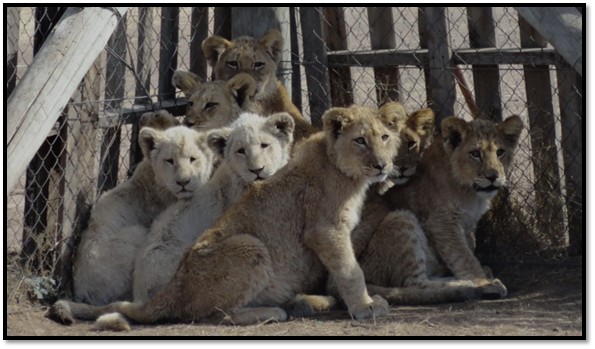
NSPCA: Lion cubs are routinely moved from their mothers to encourage her to breed again
The new Minister of the DFFE Dr Dion George backs the ban[15]
Pinnock’s view is that the DFFE has the law on its side as the Biodiversity Act 10 of 2004
permits it to restrict certain trade without a legal obligation to compensate, particularly when such trade leads to grave animal welfare contraventions. Minister George’s announcements supported the ban on the export of lion bones saying “it was unacceptable to severely compromise lions which spend their lives lame, underfed and in pain…the government needed to stop the practice…Nobody believes it is acceptable, only the people who make a lot of money out of it. As a minister, I will not have that, and the practice must end. I encourage everyone who has lion bones and derivatives to voluntarily surrender them as early as possible.”[16]
The Minister was quoted as saying, “Nobody believes [the practice of captive lion breeding] is acceptable, only the people who make a lot of money out of it. As a minister, I will not have that, and the practice must end.””[17]
Previously the Environment Department recommended a plan to acquire and dispose of legal lion bone stockpiles saying it would authorise their collection through contracts with the legal lion breeders who volunteered. They will be required to sterilise their lions ensuring they are properly cared for and agree not to add new captive lions.
The response of the organisations behind the lion breeding industry was predictably negative. Wildlife Ranching SA (WRSA) said “…the DFFE has yet to finalise an implementation plan that safeguards the livelihoods of all stakeholders involved” and urged breeders to carefully consider their participation in the process and was ready to support them with legal advice.
Details of how the plan will work have not been given, but private discussions indicate lion bones will be bought by government for their destruction.
Does captive lion breeding prevent lion extinction in the wild due to poaching, habitat loss, etc?
This argument is very speculative, although we know the lion population has declined drastically in the past decades. Dr Harvey argues that a legal supply availability through captive lions undermines any efforts to reduce the demand for lion bones. Also, that the DFFE lacks both the will and the capacity to successfully regulate the captive lion breeding industry.
He argues further that a legal trade will only displace an illegal supply through poaching when it is cheaper and that will not happen.[18]
MP’s receive a wake up call on animal cruelty from the NSPCA
Pinnock in June highlighted the presentation of Douglas Wolhuter[19] to MP’s of horrific images of captive lion breeding in South Africa showing, “Emaciated lions, open wounds, pens covered in faeces, no shelter in blazing sun, cubs on rubbish dumps, lacerated paws.”[20] Wolhuter’s visit was a plea for them to shut down the industry and remind them that the DFFE had failed to put into operation its own recommendations. He reminded MP’s, “Animal conservation cannot exist in isolation from animal wellbeing.”
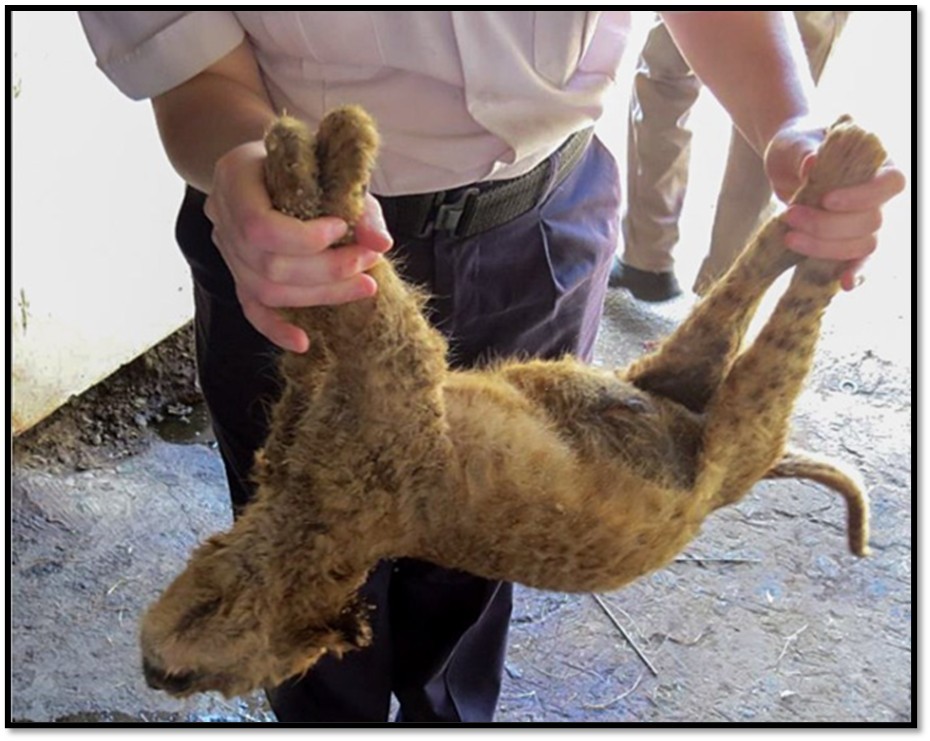
NSPCA: The end of the road for a neglected cub
Wolhuter received a warm welcome from The acting chairperson of the Environmental Oversight Committee, Dr Ronalda Nalumango (ANC) who said, “Today marks our first engagement with the NSPCA in the new administration and we are eager to foster a relationship that encourages more regular interaction…Our shared goal is to improve animal welfare and strengthen coordination among all relevant government agencies.”
MP Andrew de Blocq (DA) said, “Animal welfare enjoys unilateral support across the political parties…We all agree this is a practice that provides very few jobs and contributes negligibly to transformation but obviously has a huge negative impact on South Africa’s international reputation in terms of ethical hunting, mobility, and even tourism.”[21]
He told them, “The weight of evidence against the captive breeding industry has called for its closure, deemed irresponsible, inhumane and an unacceptable practice…I go to these places and there are cubs everywhere, conditions haven’t changed, and the levels of cruelty we find are unspeakable…If there’s a breeding ban, someone forgot to tell the lions, cubs are everywhere. The breeding continues unchecked.”
There is a lack of legal convictions for cruelty
Wolhuter reported that in 2022 alone, NSPCA inspectors carried out 176 inspections at predator breeding facilities and encountered underweight and malnourished lions,[22] unpotable water, unhygienic enclosures that lacked shelter and proper fencing and untreated infections, yet few convictions are successively made and often take years to wind through the courts. Even then penalties are capped at R40,000, or a year in prison; negligible when compared with the profits being made.
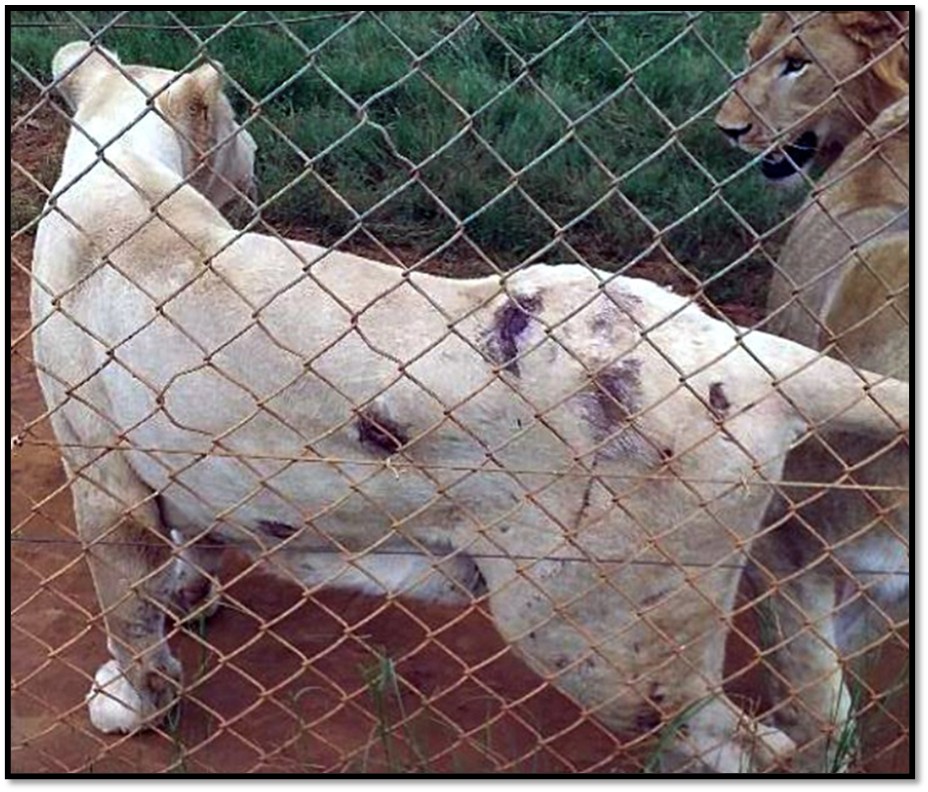
NSPCA:Veterinary care is often lacking at lion breeding facilities.
Will captive Tigers be substituted for lions?
The NSPCA fear that as lion breeding comes under further pressure to being banned, existing South African breeders will turn to other big cats, such a tigers, that are not protected under South Africa’s Threatened or Protected Species regulations.
For an excellent article, read SA government continues to defend odious trade in tigers, perpetuating their suffering in captivity[23] by Adam Cruise.
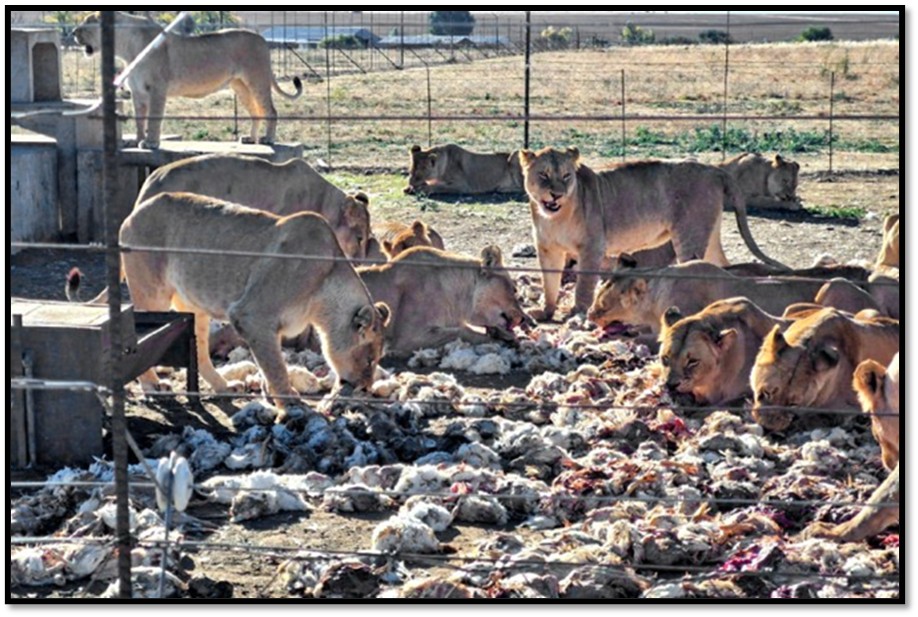
NSPCA: Nothing to eat but dead chickens
Conclusions
All commentators argue that welfare and animal conservation concerns for the lions in captivity place a responsibility on the DFFE to end the trade in lion parts.
The NSPCA is calling for:
- Immediate enforcement of the breeding moratorium;
- A government-funded joint audit of all captive lion and exotic big cat facilities, with the NSPCA involved as a legal requirement;
- Revamped penalties under the Animals Protection Act to reflect the seriousness of violations;
- A task-specific judicial unit to expedite wildlife cruelty cases; and
- A commitment that tigers and other exotics will not become the next victims of a collapsing regulatory framework.[24]
Pinnock concludes that only time will tell (and the process is being dragged out by established lion breeding interests) if the wellbeing of wild animals will finally be entrenched in law, or if financial interests of a minority of breeding farms and hunting outfits will triumph. The draft National Biodiversity Economy Strategy issued in March 2024 discloses a goal of increasing the GDP contribution for consumptive use of game from extensive wildlife systems from R4.6 billion (2020} to R27.6 billion by 2036; not a positive sign for the banning of lion breeding.
This is a worrying sign in the National Biodiversity Economy Strategy, which promotes increased commodification of wild animals.
References
D. Pinnock. Daily Maverick. 04 June 2025. Parliament backs NSPCA demand to end captive lion breeding in SA. MPs join NSPCA in demanding end to captive lion breeding in South Africa
D. Pinnock. Daily Maverick. 18 March 2025. Lion bones back in the crossfire after breeders challenge sales ban Lion bones back in the crossfire after breeders challenge sales ban
D. Pinnock. Daily Maverick. 17 Nov 2024. Hand over your lion bone stockpiles for destruction, minister tells breeders https://www.dailymaverick.co.za/article/2024-11-17-hand-over-your-lion-bone-stockpiles-for-destruction-minister-tells-breeders/
A. Cruise. Daily Maverick. 20 Nov 2024. Business as usual for captive lion breeding after SA government keeps the door open
Dr Ross Harvey. The Conversation. 30 July 2019. Captive lion breeding in South Africa: the case for a total ban. https://theconversation.com/captive-lion-breeding-in-south-africa-the-case-for-a-total-ban-121131
[1] See the article Canned Lion hunting and the horrible trade to the Far East in wild animal parts under Matabeleland North on the website www.zimfieldguide.com
[2] Inclusion on the red list means that tigers face a high risk of extinction in the wild
[3] See the article South Africa makes the correct decision on the future of wildlife including lion breeding, rhino horn and the elephant ivory trade under Matabeleland North on the website www.zimfieldguide.com
[4] Wellbeing being defined in the legislation as: “The holistic circumstances and conditions of an animal, which are conducive to its physical, physiological and mental health and quality of life, including the ability to cope with its environment.”
[5] Pinnock draws attention to another legal challenge in September 2024 from the SA Hunters and Game Conservation Association (SAHGCA) over the definition of the word ‘wellbeing.’ SAHGCA promotes the interests of game farmers, professional hunters and hunter tourists and says the definition of the word presents a threat to hunting
[6] Lion bones back in the crossfire after breeders challenge sales ban
[7] The International Union for Conservation of Nature (IUCN) estimates there are 20,000-25,000 wild lions left in Africa. Captive lions are not included in that number, but this compares with using the median value of 10,000 captive lions
[8] Hunter tourists will find that black maned lions have the highest prices
[9] Lion bones back in the crossfire after breeders challenge sales ban
[10] Male cubs typically leave their mother 18-24 months after birth; females may stay with the pride and their mothers for life
[11] NSPCA National Council of Societies for the Prevention of Cruelty to Animals
[12] Captive lion breeding in South Africa: the case for a total ban
[13] CITES (the Convention on International Trade in Endangered Species of Wild Fauna and Flora) is an international agreement between governments. Its aim is to ensure that international trade in specimens of wild animals and plants does not threaten the survival of the species.
[14] Lion bones back in the crossfire after breeders challenge sales ban
[15] This followed a recommendation from the previous Environment minister, Barbara Creecy for voluntary exit options from the captive lion industry, including the ending of lion bone stockpiles and derivatives (carcasses, skeletons, skins, teeth, claws and other parts)
[16] Hand over your lion bone stockpiles for destruction, minister tells breeders
[17] Ibid
[18] Captive lion breeding in South Africa: the case for a total ban
[19] Wolhuter is the national chief inspector and manager of the NSPCA’s Wildlife Protection Unit
[20] Parliament backs NSPCA demand to end captive lion breeding in SA
[21] Parliament backs NSPCA demand to end captive lion breeding in SA
[22] Often the lions are fed just chicken carcasses — with no supplements, resulting in serious medical conditions such as metabolic bone disease. “Their bones are so weak, they can be cut through with a knife. It’s a slow death sentence.”
[23] https://www.dailymaverick.co.za/article/2025-04-22-sa-government-continues-to-defend-odious-trade-in-tigers/
[24] Parliament backs NSPCA demand to end captive lion breeding in SA
